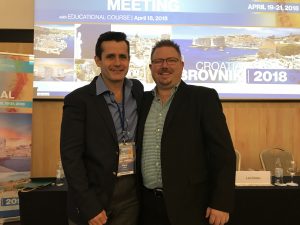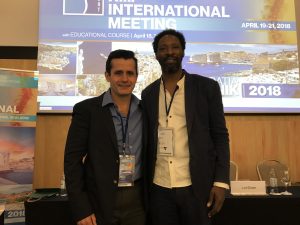The idea of traveling to Dubrovnik, Croatia, made it a very easy decision to attend this years SOSORT conference. As expected it turned out to be a very beautiful venue with amazing views and sunsets while at the same time I was able to be updated with the latest knowledge and developments in every area concerning scoliosis.
It was great to renew acquaintances and meet different scoliosis experts from throughout the world. Over 250 delegates had travelled from 37 countries including Australia, Singapore, Hong Kong, Turkey, North America and from all over Europe to present the latest developments in research on scoliosis to help scoliosis sufferers throughout the world.
I was able to spend time with Dr Jeb McAviney from Scolicare, Australia, the developer of Scolibrace and learn of new developments in the bracing system. He was presenting research on the accuracy and efficacy of ScoliScreen as a online tool that can be used in the initial screening for scoliosis. This was a pilot study and showed that ScoliScreen was accurate as a screening tool and deserved more research into its effectiveness. You can find the ScoliScreen app on our clinic website.
Dr McAviney also presented a case study on the treatment of a 11 week old boy with Infantile Idiopathic Scoliosis. Traditional gold standard treatment will typically require serial hard plaster casting up until the age of 2 years, this is usually done under a general anaesthetic which may adversely affect the child’s brain development. Once the child was determined to not have any underlying medical issues that could cause scoliosis, Dr McAviney made a rigid over-corrective 3D brace with computer generated imaging which doesn’t require anaesthetisation and rigid casting. The brace was gradually built up to being worn 6 hours per day for the following 8 months, at the end of that time the curve had reduced from 31 to 7 degree’s. This case study, was a great step forward in building evidence on rigid over-corrective bracing in infants as it means that they may not necessarily have to be in a full time plaster cast which cannot be removed and need another general anaesthetic every time a new brace is done.
I was able to meet and spend time with Mr Tony Betts one of the head physiotherapists at the Royal Orthopaedic Hospital in Stanmore. Mr Betts has worked with scoliosis patients for many years and has a wealth of knowledge on the various treatment approaches to scoliosis. He has been trained in a variety physiotherapy scoliosis exercise techniques and lectures on scoliosis, so it was great to discuss with him the different exercise approaches towards scoliosis.
One point that was re-iterated by several speakers including the conference organisers Dr Suncica Bulat Wuersching & Andreas Wuersching during the conference was the age sensitive time that adolescent idiopathic scoliosis develops and the importance in management of associated psychological factors. Adolescents can find brace wear challenging at times and will often report their brace wearing time to be greater than the actual brace wear time. In patients where brace wear is less than prescribed the effectiveness of bracing significantly reduces. When patients are able to speak and talk freely with appropriately trained psychologists and supportive parents, brace compliance improves. This re-iterates that bracing success not only depends upon the adolescent, but also upon the support of their family, friends and healthcare team.
What was most inspiring about the conference was the fact that, so many different professions from all over the world had come together to improve the lives of people with scoliosis. This focus is paving the way towards improving earlier diagnosis and risk analysis, less invasive and more appropriate treatment, more effective exercise and bracing treatment, understanding longer term prognosis and outlook and a better overall patient experience. This means that exciting times lay ahead for patients as the international knowledge base builds, enabling scoliosis to be detected earlier so the right treatment is given and progression prevented.





